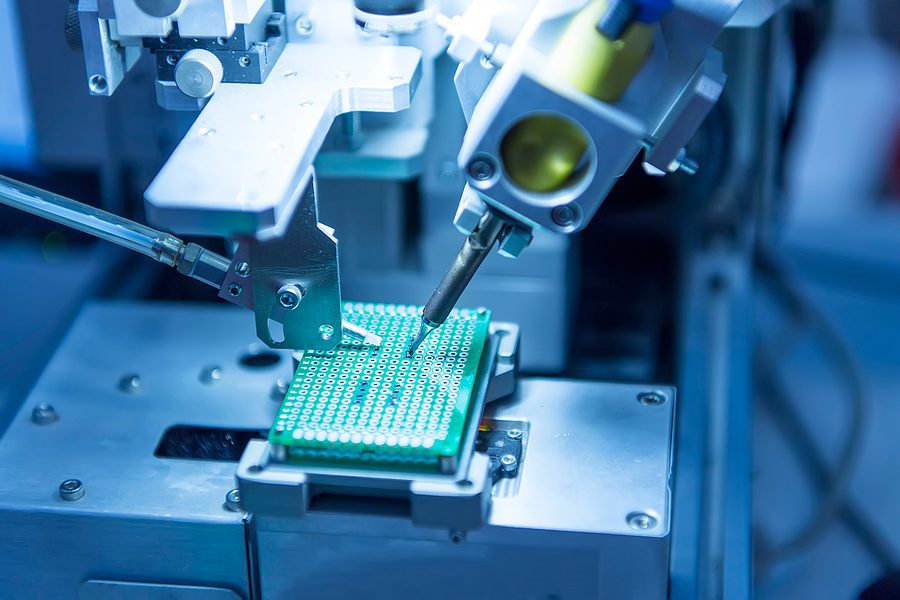When to Consider Using a Multilayer Printed Circuit Board
Printed circuit boards (PCBs) have become an integral part of the devices we love and use daily. They are everywhere we look from handheld portable electronic devices to industrial machines, communication devices, and consumer electronics. Today’s PCBs are more complex and contain different shapes and materials. They can be flex or rigid and contain a variety of components that are wired together to perform a specific application, but this is only made possible because of multilayer PCBs.

What is a Multilayer PCB?
Multilayer Printed Circuit Boards contain at least three layers of copper foil, not to be confused with a single- or double-layer PCB. A multilayer PCB must contain more than two conductive layers of material or copper layer to be considered a multilayer PCB.
Advantages of Multilayer PCBs
From a technical standpoint, multilayer PCBs provide several advantages in their design, including:
- Lightweight Construction-Smaller PCBs involve less weight which is beneficial for modern electronics that are geared toward greater mobility.
-
- Small Size-One of the most significant advantages of using multilayer PCBs is their compact size. The current trend of working with modern electronic devices is working towards smaller but more powerful gadgets.
- High Quality-the creation of multilayer PCBs requires a heavy amount of planning and work, so these types of PCBs tend to be higher quality than single- and double-layer PCBs.
- Greater Durability-Multilayer PCBs are more durable by nature. Not only must they withstand their own weight, but they must also withstand the heat and pressure used to bind them together.
-
- Enhanced Flexibility-The flexibility factor is highly significant for applications where mild bending and flexing may occur on a semi-regular basis.
- Better Performance-Multilayer PCBs are extreme high-density assemblies, incorporating multiple layers into a single PCB. This compactness enables boards to be more connective and in turn they can achieve greater capacity, power, and speed despite their smaller size.
- High-Speed Signal Transmission-One of the most important benefits of a multilayer PCB is the ability to support high-speed signal transmission.
- Increased Efficiency-Multilayer PCBs are more efficient than other types of circuit boards. Since they contain more than two layers of electrical connection, they can be used to create smaller, more efficient circuits.
Common Uses for Multilayer PCBs
Thanks to their lightweight and compact design, multilayer PCBs are considered the best choice for several industrial applications. Below are some of the most common uses for multilayer PCBs:
- Medical Devices-Electronic devices are critical to the medical industry. Multilayer PCBs can meet the specific demands of these devices due to their small size, lightweight design, and powerful features. Some examples include x-ray equipment, CAT scanning equipment, blood pressure and sugar testing devices, MRIs, CT scans, and infrared temperature monitoring.
- Consumer Electronics-Consumer electronics, often called home electronics, cover a wide range of electronic equipment intended for daily use. These devices are most used for communication, like smartphones, but are commonly found in laptops, smart televisions, microwaves, and washing machines as well.
- Industrial Electronics-Industrial electronics significantly differ from consumer electronics. They must withstand harsh environments including shock, high temperatures, pressure, vibrations, dust, and sometimes humidity. Examples include automated assembly lines, packaging conveyors, and spray painting robots.
- Computers and Devices-It’s nearly impossible to imagine a world without computers today. Everything from computers to related products like graphics cards, motherboards, and a computer mouse all contain multilayer PCBs.
- Telecommunication Electronics-Multilayer PCBs are used in many telecommunication devices like GPS, satellite applications, and signal transmission which requires extreme durability while still maintaining high functionality. Thanks to the development of wireless technology, there is a huge demand for high-performance miniature devices which multilayer PCBs can fulfill. Other applications of telecommunication electronics include communication towers, radar electronics, power amplifiers, attenuators, and more.
- Military, Aerospace, and Defense-Much like other industries, multilayer PCBs are becoming a priority for military and defense applications. Regarded for its compact design, low weight, durability and functionality, these PCBs are high-speed devices. Unmanned Ground Vehicle (UGV), aircraft defense system, and avionics are some examples of devices equipped with multilayer PCBs.
Looking for a Multilayer PCB Partner?
The demand for multilayer PCBs is only going to get stronger, as high-speed and performance technologies continue to evolve. Multilayer PCB technology is one of the many manufacturing services provided by Levison Enterprises. Whatever your product goals, our team of experienced designers and engineers will work with you to ensure your next project is a success.
Contact us today for a quote.
